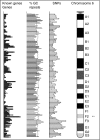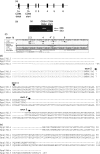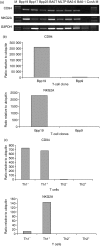Differential induction of CD94 and NKG2 in CD4 helper T cells. A consequence of influenza virus infection and interferon-gamma?
- PMID: 17462078
- PMCID: PMC2265943
- DOI: 10.1111/j.1365-2567.2007.02563.x
Differential induction of CD94 and NKG2 in CD4 helper T cells. A consequence of influenza virus infection and interferon-gamma?
Abstract
Influenza A virus causes worldwide epidemics and pandemics and the investigation of memory T helper (Th) cells that help maintain serological memory following infection is important for vaccine design. In this study we investigated CD94 and NKG2 gene expression in memory CD4 T-cell clones established from the spleens of C57BL/10 (H-2(b)) and BALB/c (H-2(d)) mice infected with influenza A virus (H3N2). CD94 and NKG2A/C/E proteins form heterodimeric membrane receptors that are involved in virus recognition. CD94 and NKG2 expression have been well characterized in natural killer (NK) and cytotoxic T cells. Despite CD94 being potentially an important marker for Th1 cells involved in virus infection, however, there has been little investigation of its expression or function in the CD4 T-cell lineage and no studies have looked at in-vivo-generated Th cells or memory cells. We show in this study that in-vivo-generated CD4 Th1 cells, but not Th2 cells, exhibited full-length CD94 and NKG2A gene expression following activation with viral peptide. For NKG2A, a novel 'short' (possibly redundant) truncated isoform was detectable in a Th2 cell clone. Another member of the NK receptor family, NKG2D, but not NKG2C or E, was also differentially expressed in Th1 cells. We show here that CD94 and NKG2A may exist as multiple isoforms with the potential to distinguish helper T-cell subsets.
Figures




Similar articles
-
Persistent expression of CD94/NKG2 receptors by virus-specific CD8 T cells is initiated by TCR-mediated signals.Int Immunol. 2004 Sep;16(9):1333-41. doi: 10.1093/intimm/dxh136. Epub 2004 Aug 9. Int Immunol. 2004. PMID: 15302848
-
Expression of CD94 and NKG2 molecules on human CD4(+) T cells in response to CD3-mediated stimulation.J Leukoc Biol. 2001 Aug;70(2):219-24. J Leukoc Biol. 2001. PMID: 11493613
-
Activating CD94:NKG2C and inhibitory CD94:NKG2A receptors are expressed by distinct subsets of committed CD8+ TCR alphabeta lymphocytes.Eur J Immunol. 2004 Dec;34(12):3456-64. doi: 10.1002/eji.200425210. Eur J Immunol. 2004. PMID: 15517612
-
The cell biology of the human natural killer cell CD94/NKG2A inhibitory receptor.Mol Immunol. 2005 Feb;42(4):485-8. doi: 10.1016/j.molimm.2004.07.031. Mol Immunol. 2005. PMID: 15607803 Review.
-
[CD94/NKG2A--a kind of inhibitory receptor belonging to C-type lectin superfamily].Zhongguo Yi Xue Ke Xue Yuan Xue Bao. 2002 Dec;24(6):653-5. Zhongguo Yi Xue Ke Xue Yuan Xue Bao. 2002. PMID: 12905700 Review. Chinese.
Cited by
-
Short Communication: Expression of APOBEC3G and Interferon Gamma in Pleural Fluid Mononuclear Cells from HIV/TB Dual Infected Subjects.AIDS Res Hum Retroviruses. 2015 Jul;31(7):692-5. doi: 10.1089/AID.2014.0297. Epub 2015 Jun 4. AIDS Res Hum Retroviruses. 2015. PMID: 25924204 Free PMC article.
-
CD127+ CD94+ innate lymphoid cells expressing granulysin and perforin are expanded in patients with Crohn's disease.Nat Commun. 2021 Oct 6;12(1):5841. doi: 10.1038/s41467-021-26187-x. Nat Commun. 2021. PMID: 34615883 Free PMC article.
-
Identification of human cytotoxic ILC3s.Eur J Immunol. 2021 Apr;51(4):811-823. doi: 10.1002/eji.202048696. Epub 2021 Jan 27. Eur J Immunol. 2021. PMID: 33300130 Free PMC article.
-
Circulating mature granzyme B+ T cells distinguish Crohn's disease-associated axial spondyloarthritis from axial spondyloarthritis and Crohn's disease.Arthritis Res Ther. 2021 May 22;23(1):147. doi: 10.1186/s13075-021-02531-w. Arthritis Res Ther. 2021. PMID: 34022940 Free PMC article.
-
Tumor-necrosis factor impairs CD4(+) T cell-mediated immunological control in chronic viral infection.Nat Immunol. 2016 May;17(5):593-603. doi: 10.1038/ni.3399. Epub 2016 Mar 7. Nat Immunol. 2016. PMID: 26950238
References
-
- Oldstone MBA. Viruses, Plagues and History. Oxford: Oxford University Press; 1998.
-
- Wiley DC, Wilson IA, Skehel JJ. Structural identification of the antibody-binding sites of Hong Kong influenza haemagglutinin and their involvement in antigenic variation. Nature. 1981;289:373–8. - PubMed
-
- Air GM, Els MC, Brown LE, Laver WG, Webster RG. Location of antigenic sites on the three dimensional structure of the influenza N2 virus neuraminidase. Virology. 1985;145:237–48. - PubMed
-
- Yewdell JW, Hackett C. Specificity and function of T lymphocytes induced by influenza A viruses. In: Krug R, editor. The Influenza Viruses. New York: Plenum Press; 1989. pp. 361–429.
-
- Doherty PC, Christensen JP. Accessing complexity. the dynamics of virus-specific T cell responses. Annu Rev Immunol. 2000;18:561–92. - PubMed
MeSH terms
Substances
LinkOut - more resources
Full Text Sources
Other Literature Sources
Research Materials

